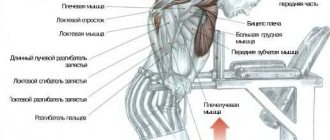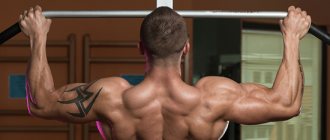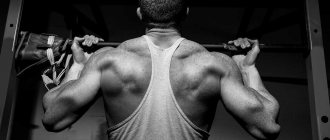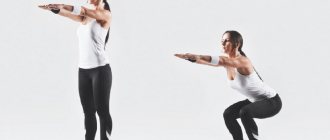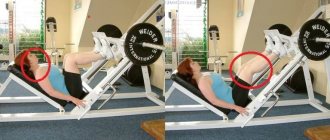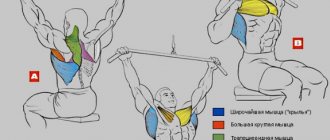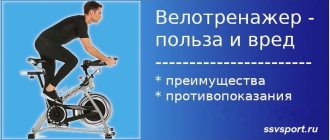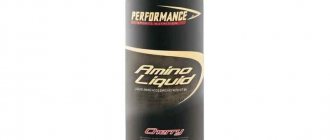Push-ups for the pectoral muscles on parallel bars have become a real classic. This is due to the fact that with ease of execution and no need for a complex simulator, any athlete can develop a powerful chest.
This is due to the fact that, unlike regular push-ups, in which part of the athlete’s weight rests on the legs, reducing the intensity of the movement, on the uneven bars the athlete is in a free position and can add weight if desired.
Nuances of performing the exercise
Many people are interested in which muscles work the most during dips.
The answer to this question cannot be unambiguous. Depending on the width of the projectile, the inclination of the body and the angle of arm extension, the load can be distributed differently.
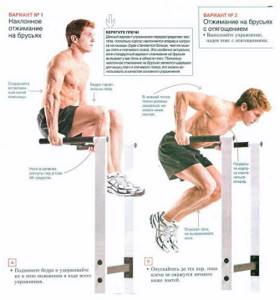
In order to focus on working the chest, you need to choose a projectile slightly wider than your shoulders.
During the active phase, the elbows should move away from the body.
Thus, most of the work of lifting the body to its previous position will be done by the lower and outer part of the chest.
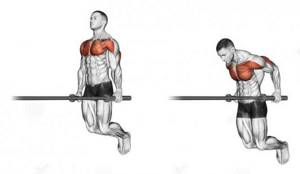
Triceps dips must be performed according to different rules.
The body should be positioned vertically, and the arms should be pressed to the body, the elbows should be pulled back during the descent.

Of course, it cannot be said that the chest is turned off, but most of the work is still done by the back of the arms.
Muscle load
In order to understand what the differences are in the technique of performing push-ups with an emphasis on the triceps and on the chest, let’s look at the mechanics of the work of the mentioned muscle groups.

In general, dips on parallel bars involve:
- Triceps - take on the bulk of the work when performing the movement correctly.
- The pectoralis major muscles help the triceps and pull the load on themselves if the technique is not followed. Then we get chest push-ups.
- Deltoid muscles of the shoulder (anterior bundle). They do not play a leading role in this exercise, so we will not dwell on them.
The main function of the triceps is to extend the arm at the elbow joint. The long head is also involved in shoulder extension and adduction of the shoulder to the body. The pectoral muscles work in synergy with the triceps. However, their main function is to bring the arms to the body and rotate them inward.
To give the triceps maximum training and at the same time reduce the “stealing” of the load by the chest muscles, you need to remove the contraction of the arms from the movement as much as possible, and leave the raising and lowering of the body due to the extension and flexion of the elbows. In other words, you need to place your hands narrowly and not spread your elbows to the sides.
The detailed technique for performing the exercise will be given below. The main thing now is to understand the principle of performing the movement.
As for the safety of doing dips, it is important to take into account that the exercise creates stress on the elbow and shoulder joints, as well as on the wrists. That is, if you have weak shoulder girdle muscles or have had any joint injuries, you should perform the exercise extremely carefully, carefully listening to your sensations. Perhaps you should start doing push-ups with a partial amplitude, and then, when the muscles get used to the load, move on to the full amplitude.
Dips for triceps go well with bent-over arm extensions, close-grip push-ups, reverse push-ups, and close-grip presses.
Pros and cons of dips
All bodybuilders and powerlifters, and even fighters trying to build muscle mass, all use this exercise.
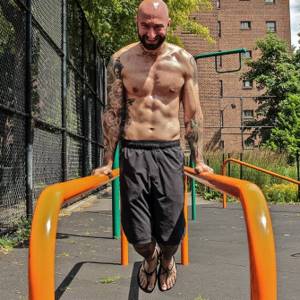
Correctly performed dip technique allows you to efficiently work out all areas, giving strength and volume to the muscles. Therefore, they are included in the training program of all successful athletes.
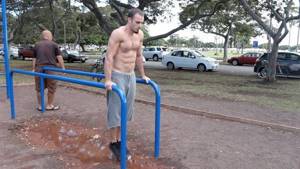
Regular exercise also allows the development of small tissues responsible for the rotation of the shoulders and shoulder blades.
As a result, the back becomes straighter, the posture takes on the appearance of a wheel, which looks like the chest bulging forward and the deltoid muscles pushed back.

However, this is not the safest bodyweight exercise available.
The peculiarity of the movement involves the active work of the shoulders. Because of this, in case of injury or pain, you need to stop performing so as not to worsen the consequences.

Before starting to do push-ups on parallel bars, a beginner needs to spend at least a month doing regular, classic exercises on the floor.

How to replace dips?
Not everyone can do dips from scratch, so many novice athletes are interested in what can temporarily replace them.
First, you can always do classic push-ups. At home, you can put two chairs and raise your legs to a right angle with your body. Or simply place them on the surface, bending your knees. This option is also suitable for girls, as it is considered lightweight. You can also try push-ups with your fists or dumbbells. While working, press your elbows tightly against your body - this way you will imitate the desired technique as accurately as possible.

Our publication has come to an end, we have considered the topic of push-ups on uneven bars, as they say, from A to Z. We also recommend watching video instructions on Youtube - so you will see everything that was said above clearly. Make sure that you have no contraindications and do not try to break the world record in the first week. By the way, it belongs to the British Simon Kent, who was able to do as many as 3989 push-ups in an hour! The record has not been broken for more than 20 years.
Exercise technique
In order to prevent unnecessary injuries during execution, it is advisable to begin the exercise with a body slightly prepared in home training conditions.
You should not chase quantity, as this will not give a tangible result. All movements must be performed in full amplitude, without jerks or sudden jolts.
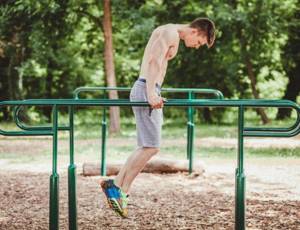
It is advisable to follow the following recommendations:
- Before starting classes, stretch your shoulders and elbows well. Basic movements involve two joints, which by their nature are the most traumatic. Stretch all delts and twist your arms away from you and towards you, do 20-30 push-ups from the floor.
- You need to start training from the top point. Pressing it to your chest will save your neck from being crushed and pinched. The hands are located slightly wider than the shoulders and turned inward.
- You need to lower as slowly as you inhale. An excellent result would be to reach the bottom point within three seconds. Having reached the final goal, fix this position for half a second.
- After this, the rise should be somewhat faster, but at the same time smoother. The ideal speed would be one and a half seconds to reach the starting position.
- After completion, do not relax your arms and fall to your feet. In this case, there is a high risk of injury. Therefore, arrange steps for yourself in advance.
To determine how wide the push-up bars should be, stand in front of them. Your shoulders should touch the handles of the apparatus.
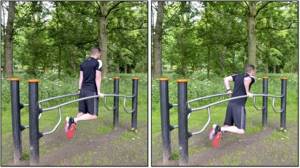
Push-up technique
- take the starting position, standing on straight arms. It is necessary that the body is in an upright position without tilting forward or backward. It is important to observe this condition throughout the exercise. Keep your shoulders, neck and back straight. Look straight ahead;
- With an inhalation, you need to carefully lower yourself down, without spreading your elbows in different directions, but moving them back. Maintain a vertical position and do not deviate from it. You will feel a significant stretch in the front of your shoulder as you begin to move. There is no need to allow pain. Usually the arms are bent at right angles. If you want to increase the load, then the amplitude must also be increased;
- to gain mass and volume, you need to resort to push-ups 3-5 sets 10-15 times. In this case, it is much more important to adhere to the correct technique than quantity. The down and up movements are performed slowly, which guarantees a significant load and effectiveness of the workout.
To perform push-ups, focusing on the triceps, it is necessary that the distance between the bars is slightly wider than the shoulders.
What should you pay attention to when doing dips to pump up your triceps?
- you should not slouch or sway while you are doing push-ups;
- avoid “hyperextending” your elbows as soon as you reach the top point, because in this case you can stretch the ligaments;
- try not to fall down as soon as you perform the movement. If the rate of descent is too rapid, there is a risk of shoulder ligament damage or muscle strain;
- there is no need to spread your elbows, as this helps reduce the load on the triceps and transfer it to another area. The triceps variation involves moving your elbows back.
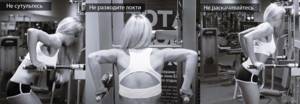
How not to do push-ups
Recommendations for performing exercises
- It is necessary to stretch your muscles before you begin any exercise on the uneven bars.
- Stick to range of motion measures. It is necessary to descend to the lowest point without overdoing the amplitude. The main thing is to maintain a comfortable feeling in the shoulder joints.
- For the effect of the exercise, press your elbows to your sides. Thus, the load is accumulated in the desired area and the exercise is carried out due to the force of the triceps.
- It would not be superfluous to stop at the lowest point, which helps reduce the inertia of movements.
- Watch your legs and keep them straight. If they are bent, the center of gravity will shift.
How can you improve your training?
Each exercise has its own nuances of implementation.
Bars help make the pectoral muscles larger, more aesthetically pleasing and stronger, even more than a barbell in the gym.
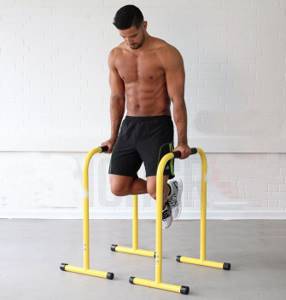
Professional athletes provide the following observations that they have made from their training:
Weighted dips allow you to accelerate weight gain when the athlete has reached his peak.
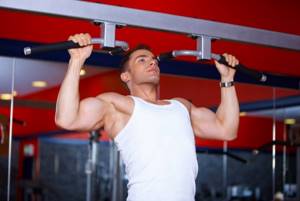
For beginners, it is advisable to perform triceps-oriented techniques. This is due to the fact that their entire chest cannot be involved in the work, since the triceps do not perform a stabilizing function efficiently.
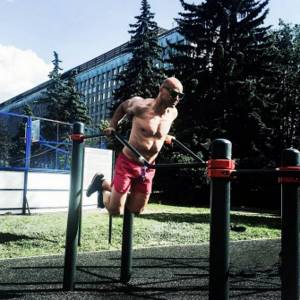
The main thing is speed of execution. Quick shudders will not lead to anything good.
So focus on inhaling slowly, as your body slowly lowers, and exhaling more quickly. But you need to maintain smooth movements all the time.
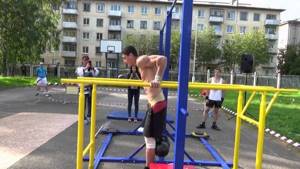
Styles and techniques for properly performing dips
As we established above, the exercise can be performed with an emphasis on the pectoral muscles or triceps. Let's take a closer look at the technique of parallel bar push-ups.
Push-ups with emphasis on the chest
This exercise can be included in the training plan along with the pectoral muscles and placed after the bench press or classic push-ups.
- We place ourselves between the bars, clasp them with our palms and straighten our arms - this is our starting position.
- To work the pectoral muscles more, the grip should be wide, but be careful: a grip that is too wide can lead to sprains and other injuries.
- We tilt the body slightly forward. The more you tilt your body, the more the load will shift to the pectoral muscles. Start with 30 degrees.
- At the same time, cross your legs and bend your knees, otherwise they will interfere with movement.
- As you inhale, lower yourself down, while spreading your elbows slightly to the sides.
- There is no need to “dive” very low; this can also cause injury. An angle of 90 degrees at the elbow joint is sufficient.
- As you exhale, at an explosive pace, we squeeze ourselves into the starting position, without straightening our arms completely.

Push-up option with emphasis on the pectoral muscles
Start with a few push-ups, as best you can, and gradually increase to 12-15 reps per set and remember to breathe properly for maximum benefit from the exercise. Do 3 to 6 approaches.
Video: How to do push-ups with an emphasis on the pectoral muscles
Push-ups with emphasis on triceps
Include this exercise option in your workout plan on the day you work on your triceps and shoulders. Combine with French presses, arm extensions and close-grip push-ups.
- We sit on the uneven bars, and our hands need to be placed with a narrower grip.
- We straighten up with outstretched arms.
- We try not to tilt the body forward. If a slight tilt still occurs, this indicates that your pectoral muscles are stronger than your triceps, and are trying to help by taking the load upon themselves. Do more close-grip presses and narrow-arm push-ups.
- As you inhale, slowly lower yourself down. At the same time, watch your elbows: in the previous version they diverged to the sides, in this version they should rush back.
- You should not go below 90 degrees at the elbow.
- Exhale and push yourself up, straightening your arms completely.

Variant of the exercise with an emphasis on the triceps muscles
We do push-ups from 5 to 15 times (as the muscles allow) in 4-6 approaches.
Video: How to do push-ups with emphasis on the triceps
Push-ups
To transfer the load with minimal risk to the joints to the chest area, you need to move your elbows not back, but at an angle of 30-45 degrees. At the same time, tilt your chin to your chest and pull your knees towards you.

The depth of immersion will be greater than with triceps exercises, this is due to the fact that the increased amplitude will have a greater effect on tissue growth.
What muscles are active during dips?
This is a basic exercise, which means it works several muscles and joints at once.
When we do push-ups, the load is predominantly distributed between the triceps (or triceps muscle) and the chest. The front deltoids (shoulders) work quite well in this exercise. Of course, the shoulder and elbow joints are active.
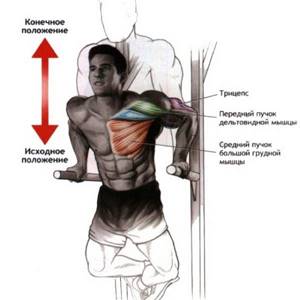
Muscles involved in dips
By changing the position of the body, the emphasis of the load can be shifted to the chest or vice versa to the triceps. If you lean forward too much, the load will go to the lower chest muscles; the same thing will happen if you grab the parallel bars with a wide grip. Accordingly, a narrow grip and a straight body will allow you to work out the triceps muscles as much as possible.
Please note that the load on the shoulder and elbow joints in this type of push-ups is much higher than with push-ups from the floor, bench or close-grip press, so if you are a beginner, try to first develop and increase joint flexibility and muscle strength in safer exercises .
Weighted push-ups
Extra weight is a great way to stimulate weight gain. But it must be taken into account that the risk of injury increases many times over.
Therefore, you should not immediately move on to large weights. It is necessary to systematically increase the load. For this purpose, the best tool would be a backpack with a dumbbell or barbell plate.
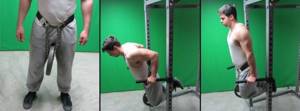
Chest muscle training on parallel bars
On the uneven bars , it is the pectoral muscles that are perfectly pumped; to do this, you just need to change the initial position so as to include shoulder compressions in the exercise. To do this, first of all, you need to spread your elbows slightly to the sides, and secondly, tilt your body. Note that in this way you will develop mainly the lower part of the chest. If your physical capabilities allow, do deep push-ups, this way you can stretch your muscles and increase their elasticity. The technique for doing chest push-ups is in another article, but let’s briefly look at the push-up technique for this muscle group
and here:
- tilt your body forward slightly;
- elbows spread to the sides;
- legs bent;
- Despite the fact that it is recommended to go deep, still do not go to extremes and build on your capabilities.
Partial range push-ups
When you have some strength left after completing the main program, there is a way to increase your dips.
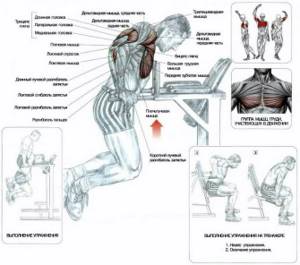
To do this, with the last of his strength, the athlete performs a partial lowering of the body, approximately 30-50 degrees down.
Mostly small muscles work, which will take on additional load in the next workout, allowing you to do more repetitions.

Contraindications
It is necessary to take into account the list of contraindications for performing exercises:
- Dips for triceps are considered a high-risk exercise if there is any serious injury to the shoulder or spine. You need to fully recover before completing them;
- If you feel pain in your joints when doing push-ups, then you need to pay attention to their flexibility and work on it. This will make you more likely to avoid rotator cuff injuries;
- Before performing exercises, attention should be paid to treating chest muscle injuries and sprains.
Dips for triceps will contribute to beautifully sculpted muscles, as well as strengthening the shoulder girdle and improving muscle coordination skills. However, you should approach this exercise carefully and follow the technique so as not to get injured and ultimately get the desired result.
Program for experienced athletes
With a strong body and proper technique, you can modify your workouts. This will not only accelerate muscle growth, but also have a good effect on the nervous system.

The following techniques can be used:
Finishing approaches with incomplete amplitude. This will allow you to spend your last strength, but you need to calculate everything correctly so as not to fall off the projectile.
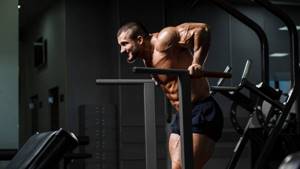
Forced approaches with insurance. In order to completely and irrevocably kill your pecs, ask your partner to back you up while performing repetitions. Lower and push until the muscles refuse to work.
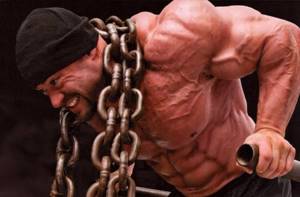
When you start performing exercises with heavy weights, take a break of no more than 10 seconds and return to the apparatus, but at the same time reducing the weight used.
Combine parallel bars and barbell exercises. The barbell bench press, like the parallel bars, is a basic, multi-joint exercise.
Changing the type of activity will cause additional stress, causing the release of hormones.
Mistakes when doing dips
To make your training as safe and effective as possible, try to do the exercise correctly, avoiding common mistakes:
- The most important thing is to protect the joints and ligaments, since the load on them during push-ups is significant, so make sure that the shoulder joints are stable, try not to swing or jerk during push-ups.
- Do not bend your hands; they should hold the handrails tightly.
- There is no need to do a speed exercise. All movements should be slow, this will allow you to better feel the muscles and reduce the likelihood of injury.
- Do not sag at the bottom so as not to create too much compression in the elbow. Movements must be performed under control.
- Do not perform the exercise with a too wide grip. It may be dangerous!
- Never start push-ups without warming up! Even if you do not get injured, slight muscle strains can certainly occur, which will later result in unpleasant painful sensations.
Programs for women
Girls need muscle mass differently than men. It would be more accurate to say that it should be located in the right place.
Approaches on uneven bars for them should not increase the volume of the chest too much, otherwise the aesthetics of the figure will be spoiled.
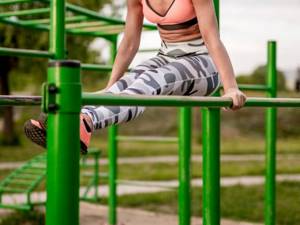
The best tool for women to tighten their entire body is the gravitron. This is a special exercise machine that has a comfortable leg support that allows you to reduce the load.
With regular and comprehensive training, this allows you to lose excess weight.
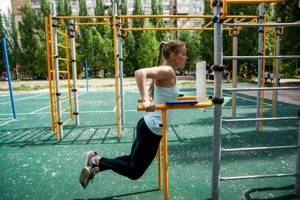
What muscles work when doing dips?
The parallel bar press is a basic exercise. This is a universal movement that is used to pump different muscle groups. Minor changes in technique can influence which muscles are used in dips.
- Chest muscles (mostly large).
- Triceps (emphasis on the long head).
These areas bear the main load (it can be changed by changing body position). Additional load and role in stabilizing the position of the arms and body falls on:
- Rotator cuff muscles.
- Front delts.
- Small pectorals.
- Serrated.
- Diamond-shaped.
- Trapezoid (lower part).
- Buttocks and abdominal area (work statically to stabilize the body).
The uniqueness of the movement lies in the fact that it applies to two different muscle groups at once. Despite the same type and similar technique, triceps and chest dips are different exercises.
The number of push-ups on the uneven bars. Weight gain
The usual number of repetitions for one approach is 8-15 times. Additional weight should be added if you are comfortable doing more than 15 reps per set (many bodybuilders do no more than 8 reps with weights). This is the basic law of increasing muscles and their strength.
Increase the weight in small steps. There is no need to immediately hang a 25-kilogram pancake on yourself - not only will you not be able to squeeze out even one repetition, but there is also a risk of injuring yourself.
Additional weight can be added in a variety of ways. For this purpose, special weights have been invented - for the arms or legs, in the form of a belt, to which an additional load is attached (weights from a barbell, dumbbells) or a vest with special weights. The best option is a belt with a load:

Source:


